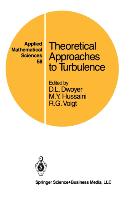- Start
- Theoretical Approaches to Turbulence
Theoretical Approaches to Turbulence
Angebote / Angebote:
Turbulence is the lIDst natural nDde of fluid lIDtion, and has been the subject of scientific study for all!Dst a century. During this period, various ideas and techniques have evolved to nDdel turbulence. Following Saffman, these theoretical approaches can be broadly divided into four overlapping categories -- (1) analytical lIDdelling, (2) physical lIDdelling, (3) phenomenologicalllDdelling, and (4) nurerical lIDdelling. With the purpose of stmtnarizing our =ent understanding of these theoretical approaches to turbulence, recognized leaders (fluid dynamicists, mathematicians and physicists) in the field were invited to participate in a formal workshop during October 10-12, 1984, sponsored by The Institute for CooIputer Applications in Science and Engineering and NASA Langley Research Center. Kraiciman, McCcxnb, Pouquet and Spiegel represented the category of analytical nDdelling, while Landahl and Saffman represented physical lIDdelling. The contributions of Latmder and Spalding were in the category of phenanenological lIDdelling, and those of Ferziger and Reynolds in the area of nurericalllDdelling. Aref, Cholet, Lumley, Moin, Pope and Temam served on the panel discussions. With the care and cooperation of the participants, the workshop achieved its purpose, and we believe that its proceedings published in this vol\. llre has lasting scientific value. The tone of the workshop was set by two introductory talks by Bushnell and ChaImm. Buslmell presented the engineering viewpoint while Chapman reviewed from a historical perspective developments in the study of turbulence. The remaining talks dealt with specific aspects of the theoretical approaches to fluid turbulence.
Folgt in ca. 5 Arbeitstagen
